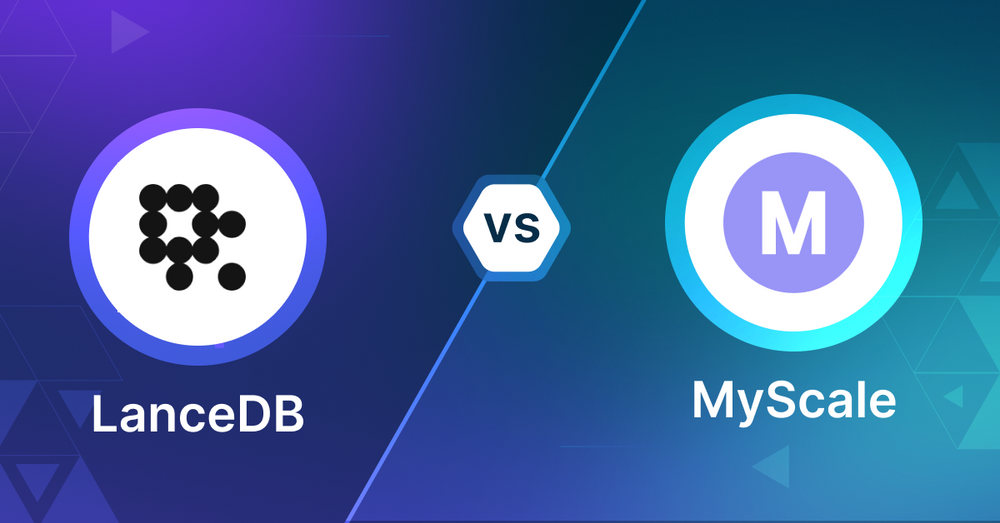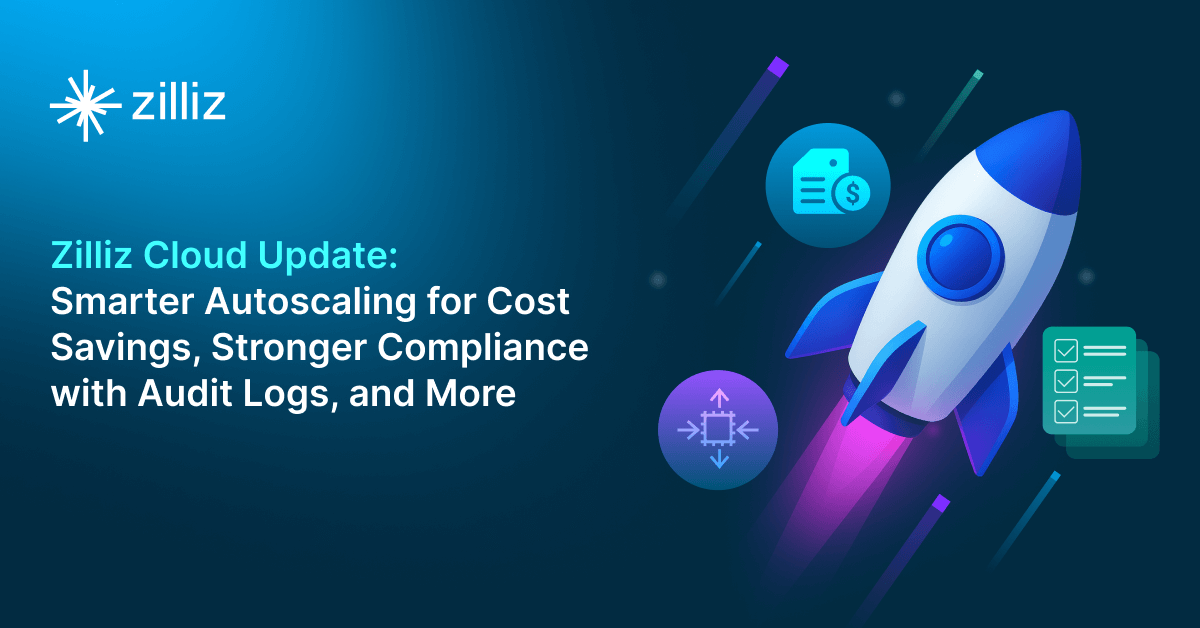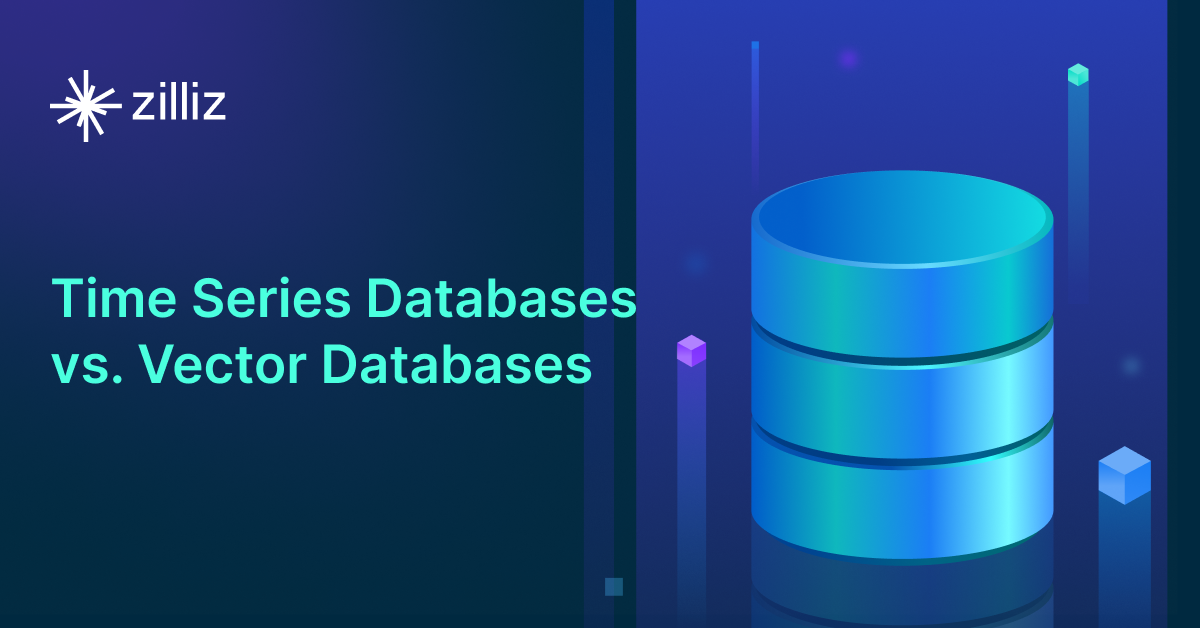LanceDB vs MyScale Choosing the Right Vector Database for Your AI Apps

What is a Vector Database?
Before we compare LanceDB and MyScale, let's first explore the concept of vector databases.
A vector database is specifically designed to store and query high-dimensional vectors, which are numerical representations of unstructured data. These vectors encode complex information, such as the semantic meaning of text, the visual features of images, or product attributes. By enabling efficient similarity searches, vector databases play a pivotal role in AI applications, allowing for more advanced data analysis and retrieval.
Common use cases for vector databases include e-commerce product recommendations, content discovery platforms, anomaly detection in cybersecurity, medical image analysis, and natural language processing (NLP) tasks. They also play a crucial role in Retrieval Augmented Generation (RAG), a technique that enhances the performance of large language models (LLMs) by providing external knowledge to reduce issues like AI hallucinations.
There are many types of vector databases available in the market, including:
- Purpose-built vector databases such as Milvus, Zilliz Cloud (fully managed Milvus)
- Vector search libraries such as Faiss and Annoy.
- Lightweight vector databases such as Chroma and Milvus Lite.
- Traditional databases with vector search add-ons capable of performing small-scale vector searches.
LanceDB is a serverless vector database and MyScale is a database built on ClickHouse that combines vector search and SQL analytics with vector search as an add-on. This post compares their vector search capabilities.
LanceDB: Overview and Core Technology
LanceDB is an open-source vector database for AI that stores, manages, queries and retrieves embeddings from large-scale multi-modal data. Built on Lance, an open-source columnar data format, LanceDB has easy integration, scalability and cost effectiveness. It can run embedded in existing backends, directly in client applications or as a remote serverless database so it’s versatile for many use cases.
Vector search is at the heart of LanceDB. It supports both exhaustive k-nearest neighbors (kNN) search and approximate nearest neighbor (ANN) search using an IVF_PQ index. This index divides the dataset into partitions and applies product quantization for efficient vector compression. LanceDB also has full-text search and scalar indices to boost search performance across different data types.
LanceDB supports various distance metrics for vector similarity, including Euclidean distance, cosine similarity and dot product. The database allows hybrid search combining semantic and keyword-based approaches and filtering on metadata fields. This enables developers to build complex search and recommendation systems.
The primary audience for LanceDB are developers and engineers working on AI applications, recommendation systems or search engines. Its Rust-based core and support for multiple programming languages makes it accessible to a wide range of technical users. LanceDB’s focus on ease of use, scalability and performance makes it a great tool for those dealing with large scale vector data and looking for efficient similarity search solutions.
What is MyScale? Overview and Core Technology
MyScale is a cloud based database built on top of the open source ClickHouse database, designed for AI and machine learning workloads. It can handle structured and vector data and real time analytics and machine learning. MyScale is focused on time series, vector search and full text search so it’s good for real time processing and AI driven insights. By using ClickHouse architecture, MyScale is high performance and scalable for AI.
One of the key features of MyScale is native SQL support which simplifies AI driven queries by integrating vector search, full text search and traditional SQL queries in one system. This reduces the need for multiple tools and makes it scalable for AI. MyScale supports and manages analytical processing of both structured and vectorized data on one platform using OLAP database architecture to operate on vectorized data. Developers can interact with MyScale using SQL so it’s accessible to all programmers familiar with relational databases.
MyScale has multiple vector index types and similarity metrics to support different use cases. It supports common distance metrics like Euclidean distance (L2), inner product (IP) and cosine similarity. The database has multiple indexing algorithms: MSTG (Multi-Scale Tree Graph), ScaNN, IVFFLAT, IVFPQ, IVFSQ and HNSW, each with its own set of parameters to tune. MyScale’s proprietary MSTG vector engine uses NVMe SSDs to increase data density so it outperforms specialized vector databases in both performance and cost.
By combining the functionality of an SQL database, vector database and full text search engine into one system MyScale reduces infrastructure and maintenance costs. This unification allows for joint data queries and analytics and a single data foundation for AI applications. MyScale also has MyScale Telemetry for full observability of LLM systems so you can monitor and debug efficiently. As data gets more complex MyScale is a future proof solution that can handle newer data modalities and database sizes while keeping computing performance and integration between different data types.
Key Differences
Search Methodology
LanceDB is optimized for vector similarity search with k-nearest neighbors (kNN) and approximate nearest neighbors (ANN) algorithms. It uses an IVF_PQ index, partitions the data and applies product quantization for efficiency. This allows for multiple distance metrics (Euclidean distance, cosine similarity, dot product) and hybrid searches that combine semantic and keyword based searches.
MyScale’s search methodology puts vector search into its SQL based platform. It has multiple indexing algorithms (MSTG, ScaNN, IVFFLAT, IVFPQ, HNSW). MyScale’s MSTG vector engine, using NVMe SSDs, increases data density for better performance. Like LanceDB it supports Euclidean distance, inner product and cosine similarity but with a unified querying approach that combines vectors, full-text and traditional SQL.
Data
LanceDB is great at handling multi-modal data, structured, semi-structured and unstructured embeddings. It’s built on Lance, an open-source columnar data format so it’s efficient to store and retrieve. Hybrid search allows you to filter on metadata fields.
MyScale is built on top of ClickHouse architecture so it can handle both structured and vector data. Its OLAP database design is made for high-performance analytics so it’s perfect for real-time AI-driven insights and time-series data.
Scalability and Performance
LanceDB is designed for scalability and cost. It can run embedded, as a serverless remote database or directly in client applications, so you have multiple deployment options. Its indexing strategy is designed for large datasets.
MyScale uses ClickHouse high-performance architecture to scale. By having SQL and vector processing on one platform it reduces the need for additional tools and simplifies infrastructure management. Its MSTG vector engine is competitive in performance at a lower cost than specialized databases.
Flexibility and Customization
LanceDB is developer focused, supports multiple languages and has a Rust-based core. Its hybrid search allows for flexible data modeling and complex query setup, perfect for recommendation systems and search engines.
MyScale is SQL first, for developers who are familiar with relational databases. Its flexible indexing and support for multiple query types (vector, full-text, traditional SQL) makes it a versatile solution for AI workloads.
Integration and Ecosystem
LanceDB integrates well with AI and ML pipelines, is compatible with existing backends and frameworks. It’s lightweight so it can be embedded in applications.
MyScale’s ecosystem benefits from ClickHouse’s tooling and integrations. Its unified SQL approach reduces friction when building and scaling AI-driven applications.
Usability
LanceDB is easy to setup and use, for developers new to vector databases. Its documentation and deployment options are clear.
MyScale’s SQL native design reduces the learning curve for developers familiar with relational databases. Its integrated telemetry tools (MyScale Telemetry) makes monitoring and debugging even simpler.
Cost
LanceDB is cost effective when deployed as an embedded or serverless database. Its open-source nature makes it even more affordable.
MyScale reduces infrastructure costs by having vector search, SQL and full-text in one system. Its resource efficiency and scalability will reduce operational costs over time.
Security
LanceDB has encryption, authentication and metadata filtering.
MyScale adds encryption, authentication and access control on top of ClickHouse security.
When to Choose Each
LanceDB is for developers working with large scale distributed data where vector search is the main focus. Open source and hybrid search makes it a great choice for applications that need semantic and keyword based searching. Being able to deploy as an embedded or serverless database makes it a great fit for many use cases.
MyScale is for scenarios that need a single system that combines full text search, vector search and SQL. It’s great for real time analytics and AI driven insights. Developers looking for an SQL native solution with strong observability will love MyScale.
Summary
LanceDB and MyScale are both great for vector search. LanceDB is great for hybrid search, flexibility and cost. MyScale is great for real time analytics and integrated AI workloads. It’s up to you to decide based on your use cases, data types and performance requirements.
Read this to get an overview of LanceDB and MyScale but to evaluate these you need to evaluate based on your use case. One tool that can help with that is VectorDBBench, an open-source benchmarking tool for vector database comparison. In the end, thorough benchmarking with your own datasets and query patterns will be key to making a decision between these two powerful but different approaches to vector search in distributed database systems.
Using Open-source VectorDBBench to Evaluate and Compare Vector Databases on Your Own
VectorDBBench is an open-source benchmarking tool for users who need high-performance data storage and retrieval systems, especially vector databases. This tool allows users to test and compare different vector database systems like Milvus and Zilliz Cloud (the managed Milvus) using their own datasets and find the one that fits their use cases. With VectorDBBench, users can make decisions based on actual vector database performance rather than marketing claims or hearsay.
VectorDBBench is written in Python and licensed under the MIT open-source license, meaning anyone can freely use, modify, and distribute it. The tool is actively maintained by a community of developers committed to improving its features and performance.
Download VectorDBBench from its GitHub repository to reproduce our benchmark results or obtain performance results on your own datasets.
Take a quick look at the performance of mainstream vector databases on the VectorDBBench Leaderboard.
Read the following blogs to learn more about vector database evaluation.
Further Resources about VectorDB, GenAI, and ML
- What is a Vector Database?
- LanceDB: Overview and Core Technology
- What is MyScale? Overview and Core Technology
- Key Differences
- Using Open-source VectorDBBench to Evaluate and Compare Vector Databases on Your Own
- Further Resources about VectorDB, GenAI, and ML
Content
Start Free, Scale Easily
Try the fully-managed vector database built for your GenAI applications.
Try Zilliz Cloud for FreeKeep Reading

Zilliz Cloud Audit Logs Goes GA: Security, Compliance, and Transparency at Scale
Zilliz Cloud Audit Logs are GA—delivering security, compliance, and transparency at scale with real-time visibility and enterprise-ready audit trails.

Zilliz Cloud Update: Smarter Autoscaling for Cost Savings, Stronger Compliance with Audit Logs, and More
Take a look at the latest release of Zilliz Cloud.

Vector Databases vs. Time Series Databases
Use a vector database for similarity search and semantic relationships; use a time series database for tracking value changes over time.
The Definitive Guide to Choosing a Vector Database
Overwhelmed by all the options? Learn key features to look for & how to evaluate with your own data. Choose with confidence.